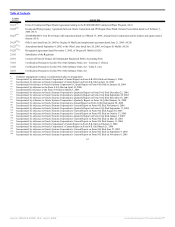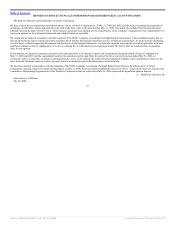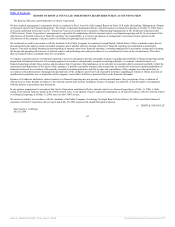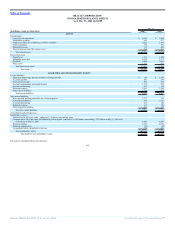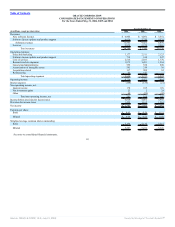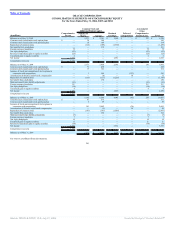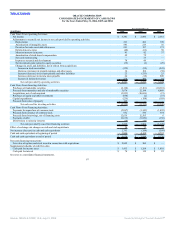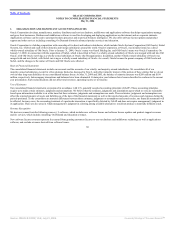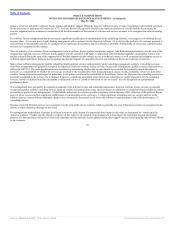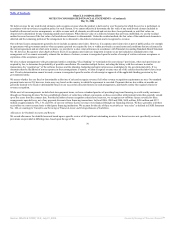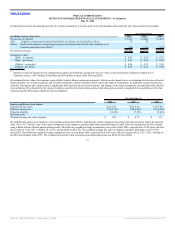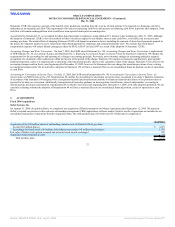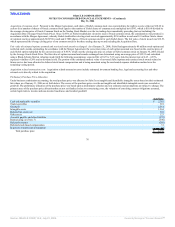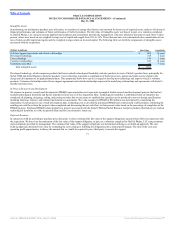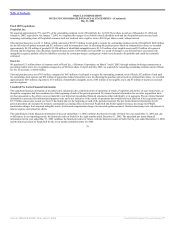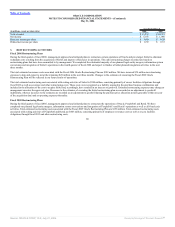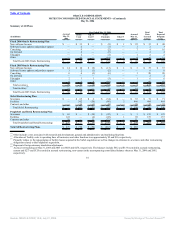Oracle 2005 Annual Report Download - page 74
Download and view the complete annual report
Please find page 74 of the 2005 Oracle annual report below. You can navigate through the pages in the report by either clicking on the pages listed below, or by using the keyword search tool below to find specific information within the annual report.
Table of Contents
ORACLE CORPORATION
NOTES TO CONSOLIDATED FINANCIAL STATEMENTS—(Continued)
May 31, 2006
receivable. In determining these percentages, we analyze our historical collection experience and current economic trends. We also record a provision for
estimated sales returns and allowances on product and service related sales in the same period the related revenues are recorded in accordance with Statement 48.
These estimates are based on historical sales returns, analysis of credit memo data and other known factors.
Concentration of Credit Risk
Financial instruments that are potentially subject to concentrations of credit risk consist primarily of cash and cash equivalents, marketable securities and trade
receivables. Investment policies have been implemented that limit investments to investment grade securities. We do not require collateral to secure accounts
receivable. The risk with respect to trade receivables is mitigated by credit evaluations we perform on our customers, the short duration of our payment terms and
by the diversification of our customer base.
Other Receivables
Other receivables represents value-added tax and sales tax receivables associated with the sale of software and services to third parties.
Marketable Equity Securities and Other Investments
In accordance with FASB Statement No. 115, Accounting for Certain Investments in Debt and Equity Securities, and based on our intentions regarding these
instruments, we classify our marketable equity securities as available-for-sale. Marketable equity securities are included in other assets in the accompanying
consolidated balance sheets and all unrealized gains (losses) are reflected net of tax in stockholders’ equity. If we determine that an investment has an other than
temporary decline in fair value, generally defined as when our cost basis exceeds the fair value for approximately six months, we recognize the investment loss in
non-operating income, net in the accompanying consolidated statements of operations. We periodically evaluate our investments to determine if impairment
charges are required.
We also have investments in privately held companies and venture funds, which are carried at cost. We review the financial condition and near term prospects of
the underlying investees, changes in the market demand for technology being sold or developed by the underlying investees and our intent regarding providing
future funding to the underlying investees in determining whether an impairment charge is required.
The net carrying value of our marketable equity securities and other investments as of May 31, 2006 and 2005 was $81 million and $60 million, respectively.
Unrealized gains in stockholders’ equity, net of tax associated with these equity securities were $11 million, $6 million and $2 million for fiscal 2006, 2005 and
2004, respectively. We had nominal impairment losses related to marketable equity securities and other investments in fiscal 2006, 2005 and 2004.
Property
Property is stated at the lower of cost or realizable value, net of accumulated depreciation. Depreciation is computed using the straight-line method based on
estimated useful lives of the assets, which range from one to fifty years. Leasehold improvements are amortized over the lesser of estimated useful lives or lease
terms, as appropriate. Property is periodically reviewed for impairment whenever events or changes in circumstances indicate that the carrying amount of an
asset may not be recoverable. We did not recognize any property impairment charges in fiscal 2006, 2005 or 2004.
71
Source: ORACLE CORP, 10-K, July 21, 2006 Powered by Morningstar® Document Research℠


